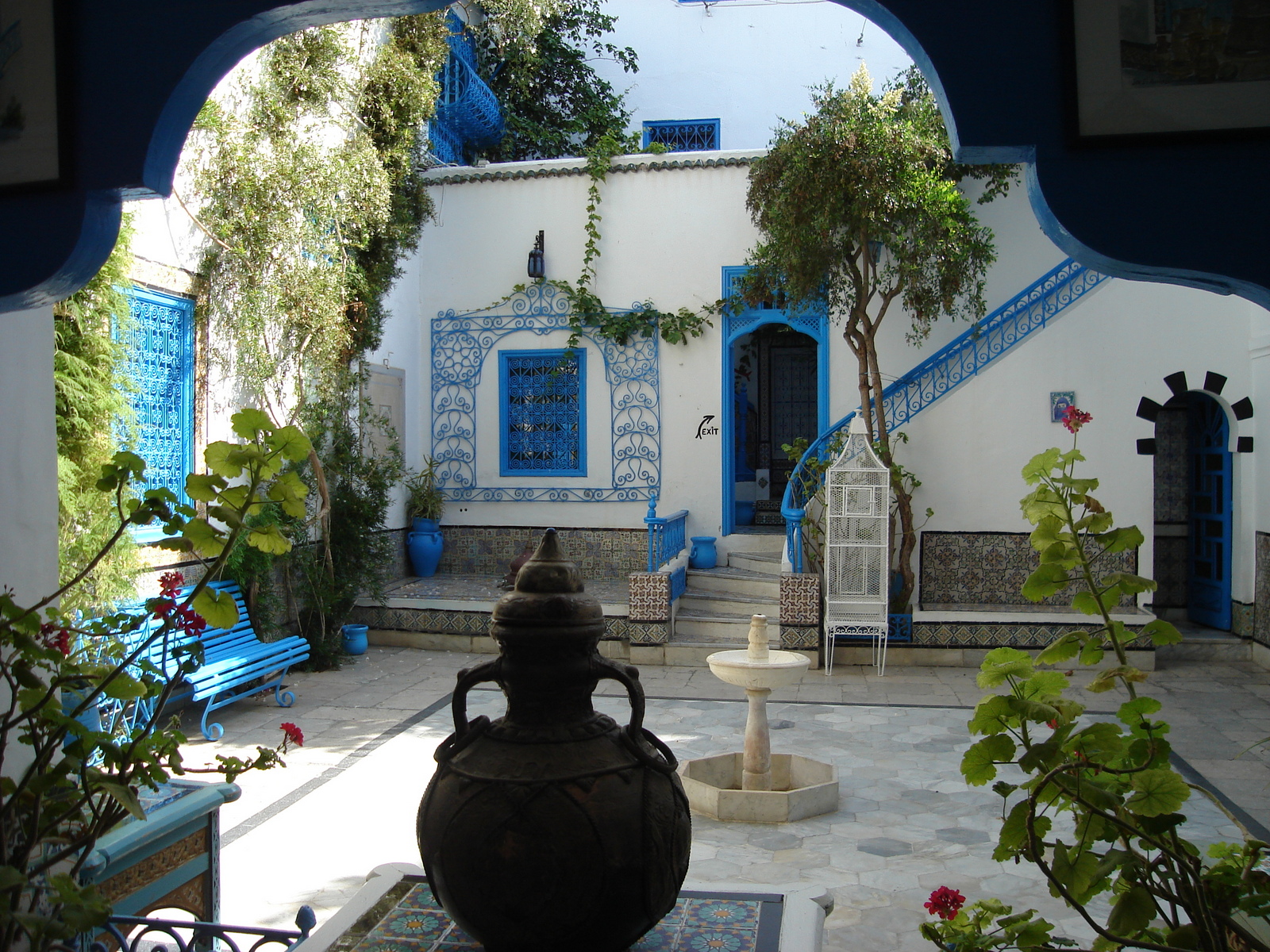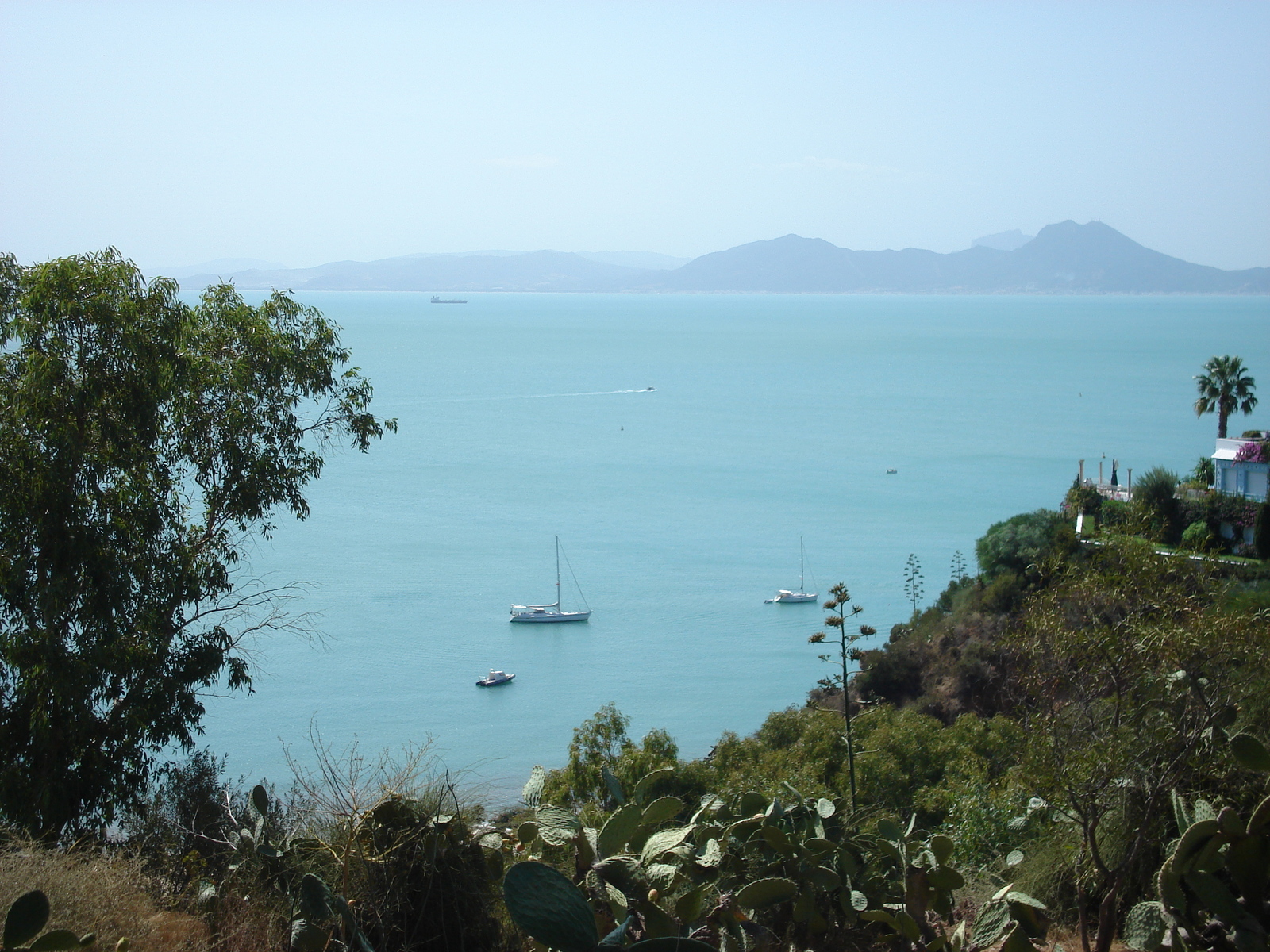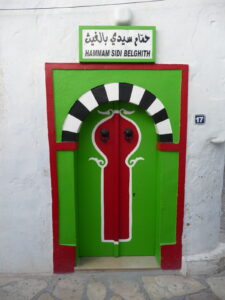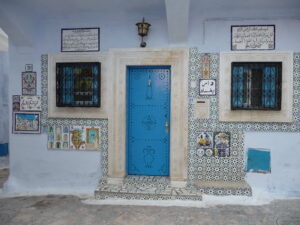We rose before sunrise and left the anchorage at Malfitano on the southern tip of the island of Sardinia at 0630 on a clear, calm morning.We set a southerly course towards the continent of Africa and within 20 minutes a nice breeze had filled in from the east.With 8 to 15 knot on our beam we had perfect sailing conditions. Along the way we were entertained by a couple of large dolphins playing in our bow wake and in the afternoon we picked up a small hitchhiking bird that clung to the side stay for a few hours until we drew close to the small island of La Galite. The nice breeze held all day and we made the 83 mile trip in eleven hours.
A hitchhiker on the way to La Galite
As we approached La Galite we were hailed by a Tunisian Coast Guard official posted in a lighthouse on a small islet to the west.He asked us the usual information of a vessel entering territorial waters (destination, last port of call, number of persons on board, nationality of crew and vessel, etc.) and then asked if we had a small boat.After an affirmative response, he requested that we anchor behind Galitons de l’Oueste and come pick him up in the dinghy.With a reasonable swell running, it was a rather dodgy place to anchor, let alone splash the dinghy, especially since we were only planning an overnight stay.We told him it was not possible, so he granted us permission to anchor at La Galite Bay for the evening. We reckoned the coastie up in the light house was either very friendly, very lonely or trying to escape.
La Galite is a large hunk barren wind-blown rock jutting out of the sea twenty miles off the coast of mainland Tunisia.The small settlement consists of a few crumbling buildings housing government workers and local fishermen.The diving is reportedly pretty good, but since we had yet to check into Tunisia we were instructed to remain on board during our stay.The wind coming off the steep island was a bit gusty but overall La Galite was a reasonable overnight anchorage for those wishing to break up the trip between Italy and Tunisia.
La Galite Island
The easterly breeze waned during the night so the next morning we motored in light airs to the mainland town of Bizerte and tied up at the visitor’s quay.Customs and Territorial Police (Immigration) came out to meet us and were very polite and efficient. We had been forewarned that the officials are not backward about coming forward for some baksheesh (gifts/bribes).We’re not sure if they’ve cleaned up their act or if they were scared off when I told them my occupation was a “journalist.”One of the officials looked quite disappointed, but we were not hassled at all.Facilities for yachts in Bizerte are very rough and minimal, but construction has commenced on a mega marina complex which should make this a major yachting destination some day.
As a New Zealander, Merima needed a 10 Dinar (US $7.50) stamp for her visa.The chief Territorial Policeman was kind enough to drive me (a scary ride as the Tunisians are horrible drivers) to an ATM and then the government office in town where I could purchase the stamp.It was during the holy month of Ramadan, so the government office was closed but we finally found the miniscule stamp at a copy kiosk.Our check-in to Tunisia was completed by the end of the day without drama and just few small gifts we offered to the three officials.
That evening we walked about a mile down the shore to the old fishing port and had dinner at a good quayside restaurant.Due to Ramadan, no alcoholic beverages were available but I enjoyed a couple “Celestial” non-alcoholic beers which were the best tasting of all the “near-beers” I’ve sampled.The specialty of the house was couscous, which was excellent.
The old fishing port at Bizerte
On the way back to the boat we stopped into a local café near the quay for a cup of tea and a sheesha.The sweet mint tea was served with pine nuts floating on the top, giving it a lovely buttery flavor.
On the way back to the boat we were stopped by rather dodgy looking character claiming to be the port captain, although he was not in uniform. I reckoned that he was just the night security guard as he had the keys to the gate and Port Captain’s office. He demanded we and the Spanish couple tied up next to us, follow him into his office.I was quite certain he was going to attempt to extract some baksheesh from us.We reluctantly followed him into his office but the ceiling was so low that I whacked my head on one of the exposed beams.I feigned dizziness and concussion and left immediately but was warned I must come back and report to him before we departed BizerteThe Spanish couple also managed to escape without paying, claiming they had not yet been to an ATM.
We slipped away from the guest quay early the next morning and anchored out in the protected harbor, managing to avoid the “Port Captain” for the remainder of our stay in Bizerte.We splashed the dinghy so we could access town via the old fishing port.When we arrived in town the first time, we were greeted by a man named Mohammed who spoke excellent English and wanted to be our guide.We told him we preferred to explore on our own and finally convinced him to leave us alone.He said he would go watch our dinghy which we had locked to a metal ring on the quay with a chain.
We spent the morning exploring the town and found the Monoprix supermarket where we picked up a few provisions.
Bizerte is a working town, with nothing much to offer the tourist other than the scenic old port and Casbah.Nonetheless it was interesting to wander around the streets of town and witness life in this town, little changed from 50 to 100 years ago.The French influence from the colonial years still remains strong in Tunisia.Most Tunisians speak French in addition to Arabic.Few people speak English so Merima dusted off her French and was able to get us by quite nicely as we found our way around and organised a SIM card for the phone and a 3G mobile Internet connection.
The town was buzzing with crowds of people going about their daily business, but all cafes and restaurants were closed during daylight hours in observation of Ramadan.From sunrise to sunset people are not permitted to eat, drink or smoke-anything.We did not see one person sipping, chewing or puffing during the days we were ashore, nor did we out of respect for those who were truly fasting.
When we got back to the dinghy there were a few local boys playing in and around it.Other than a few dirty footprints on the tubes, it was OK, but Mohammed was on the spot when we returned to collect his fee any way.We gave him a few Dinars and he was happy, but wanted us to come back in during the evening for a tour, which we politely evaded.
Every evening during Ramadan, at the official moment of sunset, a cannon was fired and a puff of smoke would appear over the town to announce that it was time to end the day’s fast.After a loud bang, it was as if someone called “gentlemen, start your barbeques!”
The gun signifies its time to eat
We returned to town the next morning to have a look at the Casbah and the old Spanish Fort.While some of the quaint old homes in the Casbah were picturesque, the streets were strewn with rubbish and decaying food.We were quickly driven away by the odor.The Spanish fort was equally underwhelming, so we walked down to the town center and local open markets to get a few fresh items.Bizerte is not really a tourist town and my guess is most of the foreign visitors would be yachties passing through.As we walked down the street a gentlemen who spoke excellent English remarked in surprise that we were speaking English.He asked what we were doing in Bizerte as if he’d never seen a western tourist there before.
An ornate door on a home in the Casbah, Bizerte
That afternoon we picked up the anchor and headed out to Cap Farina.Along the way we passed Raf Raf where there are two almost perfectly formed natural pyramids.Further down the coast was a most unusual sandstone island called Ile Pilau.The coastline varied from stunning white sand beaches to sandstone cliffs pockmarked with numerous caves.We anchored on the south side of Cap Farina below an old fort and we were the only boat there.
The natural pyramids at Raf Raf
The next day we enjoyed a nice sail to Sidi Bou Said, running with the spinnaker for a few hours before the wind gradually died out.The marina was full, so we anchored just to the south, getting a bit of protection from the easterly swell.It was bit rolly during the day, but the shore breeze in the evening put our stern to the swell allowing us a comfortable night’s sleep.
Setting out early the next morning, we walked from the marina up the steep path to the village of Sidi Bou Said. We wandered the narrow cobbled streets enjoying the whitewashed buildings with colorfully painted doors and windows.We found the Dar el-Annabi, a large and ornate home built in the 18th century which has been converted to a museum.Many of the original furnishings and artifacts remain, offering a glimpse into the posh lifestyles of times past.We were the first to arrive that day and were welcomed by a young man who is a member of the family who owns and lives in the home. We enjoyed a nice chat while sipping on a mint tea in the lovely inner courtyard.After, we wandered through dozens of exquisitely tiled and decorated rooms of the home and up to a small deck on the roof to take in the panoramic view of Sidi Bou Said, Carthage, Tunis and the Mediterranean Sea.The home is replete with family photos and memorabilia and was well worth the 3 Dinar (US $2.25) entry fee.
The peaceful inner courtyard at Dar el-Annabi
A backstreet, Sidi Bou Said
A home draped in bouganvillea, Sidi Bou Said
A narrow lane, Sidi Bou Said
A short stroll from there we found the Dar Ennejma Ezzahra, a large villa built by the French-American Baron Rudolf d’Erlanger in the early 20th century.
The Baron was a patron of the arts and this home reflected his incredible taste in every way.The interior styling is a meticulously detailed Arabian art deco with generous use of imported marbles, plaster and wood carving and gold leaf.Our guide told us that the home remains much in its original state.The walls are adorned with original paintings, many done by the Baron, and one part of the home is a museum displaying gramophones and musical instruments, many of African origin.While the exterior of the home blends with the buildings in the rest of the village, the location overlooking the sea is spectacular and the interior is simply palatial.We had the place to ourselves until just before we left and again it was great value at 16 Dinar (US $12) for the two of us including a supplement for photography and a tip for the guide.
The ornate interior of Dar Ennejma Ezzahra
Hand carving and gold leaf work in Dar Ennejma Ezzahra
View of Moonshadow anchored in the Gulf of Tunis from Dar Ennejma Ezzahra
We later explored the lovely narrow streets of the town with their intricate doors and explosions of brightly colored bougainvillea.We climbed up to the lighthouse at the highest point in town before succumbing to hunger and finding a café in town open for non-fasting tourists, where we enjoyed a tasty couscous lunch at an outdoor café.
The ornate doors of Sidi Bou Said
In a light westerly breeze we weighed anchor and headed ENE toward Cap Bon.As we approached the rocky cape, the wind filled in and gradually went forward.By the time we reached Cap Bon we were hard on the wind with 15-20 knots and 2m seas.
The interestingly shaped Ile Pilau near Cap Bon
It was a bash for a couple of hours until we clawed our way past the waves crashing on the rocks of the cape and were able to safely bear away and ease sheets. We flew the next 15 miles down the coast to Kelibia, where we took anchorage in an excellent lee, off the town and next to the local harbor.Winds dropped to 10 knots and the anchorage was flat calm-ahhhhhh!Time for a rum!
View of Le Fort from the anchorage, Kelibia
We were looking to get a bit of exercise so the following morning we took the dink into the harbor in Kelibia and walked up to “Le Fort,” an ancient fort perched atop a hill behind the harbor.After a 20 minute climb up the hill and onto the outer walls of the fort we were rewarded with great views of the town, port, beach and all the way up the coast to Cap Bon.
View from Le Fort, Kelibia
Afterwards we walked a ways towards town of Kelibia to get a closer look at a mosque with an intricate and attractive minaret.Kelibia is a quiet old town and other than the nice beach on the other side of the fort, there’s not much for tourists.The harbor is chokker with fishing boats and there is only room for 8-10 visiting yachts rafted two or three up.Kelibia has long been a boat building center and one can still see local craftsmen packing the seams on wooden boat with oakum, as it has been done for hundreds of years. The anchorage was calm and the other boat left, leaving us the only ones there.
A boatbuilder packs the seams of a fishing boat with oakum, Kelibia
A modestly dressed Muslim mermaid near the harbor, Kelibia
In light air we motor sailed to Hammamet, 40 miles down the coast and anchored near the Casbah in calm waters.Hammamet is noticeably more touristy than the towns up closer to the cape.We arrived to a flotilla of mock pirate ships full of white-skinned tourists blaring loud disco music while the crew, dressed in tacky pirate garb, performed calisthenics in the imitation rigging . The nicely restored Casbah is full of tourist shops with slightly aggressive salesmen touting their wares, but the town is pretty tidy and there were numerous food and drink establishments open before the evening gun went off. A squall came through in the late afternoon leaving a nasty swell so we didn’t get a good sleep due to the rolling.
Fishing boats on the beach, Hammamet
A Hammamet sunset
The wind shifted to the NW the next morning and the anchorage calmed down so we decided to stay one more night.We went into town that evening to celebrate Merima’s birthday and enjoyed a glass of Tunisian wine at a pub and dinner at the outdoor courtyard at Chez Anchour restaurant.The Tunisian food and local wines were both excellent.
The Casbah, Hammamet
We had come to the last sailing day of the season.Our first stop was the Marina Jasmine where we topped up the diesel tanks. It is interesting to note that at .91 Dinar (US $ .68) per liter in Tunisia, diesel, while still expensive by U.S. standards, is less than half the price than in Italy or France.
Departing the Marina Jasmine mid-morning, we capped off the season with a splendid 40-mile spinnaker run to Cap Monastir, where we would store Moonshadow for the northern hemisphere winter.We pulled into the Marina Cap Monastir right around happy hour and tied up to the fuel quay.The local officials were on the spot to check our papers, and were very polite and efficient.
The Marina Cap Monastir is the oldest in Tunisia and is showing her age a bit.The facilities are a bit rough around the edges, but the staff are most helpful and efficient and the marina itself provides excellent protection from the weather and has good security.Interestingly, the berths do no have laid moorings, so we had to provide some old lines to a diver to fix to the mooring blocks.We got it all sorted the next afternoon and were snug in our berth next to the 80’ classic maxi racing yacht Stormvogel.Her Kiwi crew Ian and Francee have her looking as gorgeous as she was when she was featured in the motion picture Dead Calm.
Stormvogel
After five months and nearly 2500 miles of zig-zagging our way around the central Med, we once again began the task of mothballing Moonshadow for the winter.
The Marina Cap Monastir
Monastir is a working town and thus has not been significantly impacted by tourism.We arrived during the final week of Ramadan and the town was buzzing.In and around the Medina or old walled section of the city, a bazaar had been set up with merchants selling all sort of things, but mostly clothing and home wares.Just making our way around was difficult.
The town of Monastir
The bazaar set up in the Medina, Monastir
The Ribat (Fort) at Monastir
As a cruising destination, Tunisia didn’t appear on our radar screen till perhaps a year ago.For cruisers looking for a place to winter over, it has a few distinct advantages.First, despite the fact that it lies on the continent of Africa, it is situated less than 200 miles from Malta and Italian Islands of Sardinia and Sicily, so it is relatively close to the prime cruising grounds of the central Med. Second, it is not a member of the European Union so it is easy to keep a non-EU vessel in Tunisia for up to a year.Tunisia has fully embraced yachting and has numerous good, secure marina facilities along its coastline and it has not become hyper-priced like its European neighbors to the north.A year in a Tunisian marina costs about the same as a month in one in one of the popular parts of Italy.Given that we did not plan to stay aboard for the winter, we felt that Tunisia would be a more reasonable option for storing Moonshadow while we are away.

































